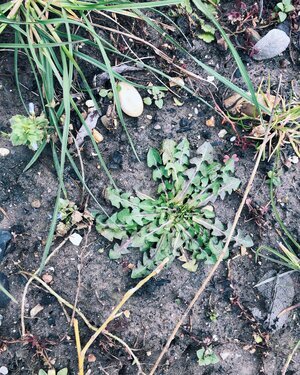EAT YOUR WEEDS
Weeding doesn’t have to be the toil that many of us dread - especially if you can glean a tasty lunch out of it! A morning weeding my herb beds gave me a colander full of delicious leaves for a herby omelette. Admittedly I shouldn’t have let the bed get so weedy, but a Spring meal was an added bonus. Perhaps your veg beds are not the place for dandelions, but do maintain wild patches on the margins of your plot. Diversity is one of the pillars of a healthy ecosystem and healthy gut. These days our diets are somewhat limited to a small number of edible plants. It’s a real buzz introducing new flavours from wild plants to the kitchen.
Edible ‘weeds’
Do bear in mind that (obviously) not all weeds are edible. Get yourself a good foraging book and be sure to identify things correctly. I love John Wright’s writing and books, and I turn to Miles Irving’s The Forager’s Handbook for its scope and culinary inspiration.
I want to focus on four species (that we consider to be weeds) that ended up in my omelette this weekend. Dandelion, Hairy Bitter Cress, Ribwort Plantain and Oxalis. But first a note on weeding…
Weedy Spring Omelette: Dandelion, Oxalis, Ribwort Plantain, Hairy Bitter Cress with Chives, Lemon Balm and Fennel Herb shoots
Weeding
Weeding is necessary to allow our vegetable plants to get the nutrients and water they need. Congested beds can also lead to pest and disease problems. I’ve spent many years down on my hands and knees, hand-trowel in hand, gently forking out weeds, or hoeing the days aways. But having introduced a ‘no dig’ system at Soho Farmhouse, I can testify to the fact that you end up with a lot less weeds than digging over your soil each winter. If you’re not familiar with ‘no dig’ check out charlesdowding.co.uk Charles’s theory on weeding, is that every time you disturb the soil by digging, you’re not only moving weed seeds to the surface, but the ground feels the need to ‘recover’ by covering itself with new plants (i.e. weeds) as it is not a natural state to have bare soil. Mulching on top of the soil with an inch or more of compost or well rotted manure instead of digging, limits this process and you only end up with weeds that arise from seeds that have blown onto the mulch. These can easily be kept on top of every few weeks as they are easy to pull out of the mulch. It’s worth noting that if you’re starting a ‘no dig’ bed for the first time, you’ll need to dig out any deep rooted perennial weeds first, but once this is done you’ll be setting yourself up well for years to come.
The weeds
The following all came out of the my herb bed on a March morning. All (in my opinion) are valuable for their flavour as well as nutrition, providing sour, bitter, earthy and spicy notes.
Hairy Bitter Cress (Cardamine hirsuta)
Hairy bitter cress (Cardamine Hirsuta)
Delicious - you’re lucky if you have this one. Not hairy like its name suggests! Tastes like watercress, cress and rocket. Nutty and spicy. More fiery just before flowering.
Beautiful rosettes can be picked whole (cut just above soil surface). Such a pretty addition to salads that packs a flavour punch.
Tiny white flowers. Mature seed heads explode cataclysmically across the bed making it a quick spreader!
Native overwintering annual
Dandelion ( Taraxacum agg.)
Dandelion ( Taraxacum Agg.)
A joyous, beauty of a plant when in flower, that for some reason we feel the need to rid from our gardens. Gives 3 useful crops from leaves, flowers and roots. See my previous post on dandelions for more ideas.
Easiest way to harness the benefits is through the leaves picked for salads. Leaves are bitter but can be blanched by placing a plant pot (holes in bottom covered) over the top of rosette to get tender leaves. But bitter is good folks! It is a flavour we don’t get enough of in our diets and supports detoxification. Mixed with other leaves or a fruity vinaigrette they are very pleasing!
Leaves are less bitter in early spring before flowering.
Vitamins A, C and K, calcium and potassium.
French name for this plant is ‘Piss-en-lit’ - piss the bed, which refers to its diuretic properties. Unwanted excess fluids are expelled though increased urination.
Native perennial
Ribwort Plantain (Plantago lanceolata)
Ribwort plantain (Plantago Lanceolata)
There are various plants in the plantain family (Plantaginaceae) including Buck’s-horn Plantain, Greater Plantain, Sea Plantain and this Ribwort.
Leaves have a slight mushroomy flavour which works great with eggs. Earthy! Flower buds taste intensely of mushrooms. Can be used raw in salads or blanched and served with dressing or butter. Yum.
Leaves are parallel ribbed in a pretty rosette.
Native perennial.
Oxalidaceae
Oxalidaceae
Oxalis leaves add a sour punch to any salad and are great with desserts too. They contain oxalic acid which can be toxic in large amounts, so don’t eat bucket loads. A sprinkle goes a long way for a sorrel like pop. And just look how delicate it is. Yellow flowers are also edible.
Oxalis can be rampant, quickly becoming invasive, so keep a check on it in veg beds.
Wood Sorrel is a native perennial to the UK (with green leaf) and can be found in moist, shady woodland but this red variety, similar in leaf shape, is an imposter! Probably developed as an ornamental garden plant, it is also a tasty edible. I’m unsure exactly which species this is - possibly Procumbant Yellow Sorrel (Oxalis corniculata) which prefers open sunny spots. It is growing on my south facing wall which is an indication this is it.






